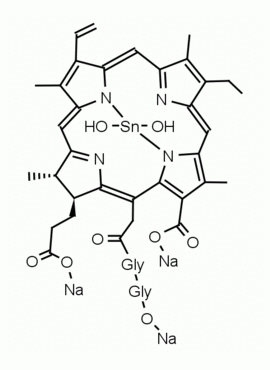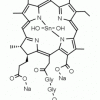Sn(IV) Chlorin e6 mono-glygly Amide Dihydroxide Trisodium Salt CAS: 1609250-37-4 MDL:
Molecular weight: 861.48 g/mol
Molecular Formula: C38H42N6O10Sn
CAS Number: 1609250-37-4
Storage: Store at room temperature, protect from light.
Synonyms: Sonoflora 1 , Sonoflora1 , Sonoflora-1 , SF1 , SF-1 , SF 1
Fields of Interest: Photodynamic Therapy, Nanocomposites, Quantum Oxygen Yield, Catalysis, Photocatalysis
Dong, Ziliang, Liangzhu Feng, Wenwen Zhu, Xiaoqi Sun, Min Gao, He Zhao, Yu Chao, and Zhuang. Liu. CaCO3 Nanoparticles as an Ultra-Sensitive Tumor-PH-Responsive Nanoplatform Enabling Real-Time Drug Release Monitoring and Cancer Combination Therapy. Biomaterials 110, no (2016): 60–70. https://doi.org/10.1016/j.biomaterials.2016.09.025.
Ferrario, Angela, David Kessel, and Charles J. Gomer. Metabolic Properties and Photosensitizing Responsiveness of Mono-L-Aspartyl Chlorin E6 in a Mouse Tumor Model. Cancer Research 52, no (1992): 2890–93.
Gomer, Charles J., and Angela. Ferrario. Tissue Distribution and Photosensitizing Properties of Mono-L-Aspartyl Chlorin E6 in a Mouse Tumor Model. Cancer Research 50, no (1990): 3985–90.
Gomer, Charles J., Stefan W. Ryter, Angela Ferrario, Natalie Rucker, Sam Wong, and Anita M. R. Fisher. Photodynamic Therapy-Mediated Oxidative Stress Can Induce Expression of Heat Shock Proteins. Cancer Research 56, no (1996): 2355–60.
Hargus, Jodie A., Frank R. Fronczek, M. Graca H. Vicente, and Kevin M. Smith. Mono-(L)-Aspartylchlorin-E6. Photochemistry and Photobiology 83, no (2007): 1006–15. https://doi.org/10.1111/j.1751-1097.2007.00092.x.
Kato, Harubumi, Kinya Furukawa, Masami Sato, Tetsuya Okunaka, Yohko Kusunoki, Masaaki Kawahara, Masahiro Fukuoka, et al. Phase II Clinical Study of Photodynamic Therapy Using Mono-L-Aspartyl Chlorin E6 and Diode Laser for Early Superficial Squamous Cell Carcinoma of the Lung. Lung Cancer (Amsterdam, Netherlands) 42, no. Copyright (C) 2021 U.S. National Library of Medicine. (2003): 103–11.
McMahon, Kimberly S., T. Jeffery Wieman, Pamela H. Moore, and Victor H. Fingar. Effects of Photodynamic Therapy Using Mono-L-Aspartyl Chlorin E6 on Vessel Constriction, Vessel Leakage, and Tumor Response. Cancer Research 54, no (1994): 5374–79.
Munowitz, Michael, Walter P. Aue, and Robert G. Griffin. Two-Dimensional Separation of Dipolar and Scaled Isotropic Chemical Shift Interactions in Magic Angle NMR Spectra. Journal of Chemical Physics 77, no (1982): 1686–89. https://doi.org/10.1063/1.444064.
Omelyanenko, V., P. Kopeckova, C. Gentry, J.-G. Shiah, and J. Kopecek. HPMA Copolymer-Anticancer Drug-OV-TL16 Antibody Conjugates. 1. Influence of the Method of Synthesis on the Binding Affinity to OVCAR-3 Ovarian Carcinoma Cells in Vitro. Journal of Drug Targeting 3, no (1996): 357–73. https://doi.org/10.3109/10611869608996827.
Omelyanenko, Vladimir, Christine Gentry, Pavla Kopeckova, and Jindrich. Kopecek. HPMA Copolymer-Anticancer Drug-OV-TL16 Antibody Conjugates. II. Processing in Epithelial Ovarian Carcinoma Cells in Vitro. International Journal of Cancer 75, no (1998): 600–608. https://doi.org/10.1002/(SICI)1097-0215(19980209)75:4<600::AID-IJC18>3.0.CO;2-C.
Roberts, W. Gregory, Kevin M. Smith, Jerry L. McCullough, and Michael W. Berns. Skin Photosensitivity and Photodestruction of Several Potential Photodynamic Sensitizers. Photochemistry and Photobiology 49, no (1989): 431–38. https://doi.org/10.1111/j.1751-1097.1989.tb09191.x.
Spikes, John D., and Jerry C. Bommer. Photobleaching of Mono-L-Aspartyl Chlorin E6 (NPe6): A Candidate Sensitizer for the Photodynamic Therapy of Tumors. Photochemistry and Photobiology 58, no (1993): 346–50. https://doi.org/10.1111/j.1751-1097.1993.tb09572.x.
———. Photosensitizing Properties of Mono-L-Aspartyl Chlorin E6 (NPe6): A Candidate Sensitizer for the Photodynamic Therapy of Tumors. Journal of Photochemistry and Photobiology, B: Biology 17, no (1993): 135–43. https://doi.org/10.1016/1011-1344(93)80006-U.
Taber, Scott W., Victor H. Fingar, Carolyn T. Coots, and T. Jeffery. Wieman. Photodynamic Therapy Using Mono-L-Aspartyl Chlorin E6 (Npe6) for the Treatment of Cutaneous Disease: A Phase I Clinical Study. Clinical Cancer Research 4, no (1998): 2741–46.
Usuda, Jitsuo, Tetsuya Okunaka, Kinya Furukawa, Takaaki Tsuchida, Yukari Kuroiwa, Yuichiro Ohe, Nagahiro Saijo, Kazuto Nishio, Chimori Konaka, and Harubumi. Kato. Increased Cytotoxic Effects of Photodynamic Therapy in IL-6 Gene Transfected Cells via Enhanced Apoptosis. International Journal of Cancer 93, no (2001): 475–80. https://doi.org/10.1002/ijc.1374.
Al-Khaza’leh, Khaled A., Khalid Omar, M. S. Jaafar, and Guat-Siew. Chew. Effect of Acidification on the Absorption and Fluorescence Properties of Sn(IV) Chlorin E6 Dichloride Trisodium Salt. Arabian Journal for Science and Engineering 36, no (2011): 597–606. https://doi.org/10.1007/s13369-011-0055-7.
Cheng, J., J. Xu, J. Duanmu, H. Zhou, C. J. Booth, and Z. Hu. Effective Treatment of Human Lung Cancer by Targeting Tissue Factor with a Factor VII-Targeted Photodynamic Therapy. Current Cancer Drug Targets 11, no. Copyright (C) 2021 U.S. National Library of Medicine. (2011): 1069–81.
Duanmu, J., J. Cheng, J. Xu, C. J. Booth, and Z. Hu. Effective Treatment of Chemoresistant Breast Cancer in Vitro and in Vivo by a Factor VII-Targeted Photodynamic Therapy. British Journal of Cancer 104, no. Copyright (C) 2021 U.S. National Library of Medicine. (2011): 1401–9.
Friedberg, J. S., R. G. Tompkins, S. L. Rakestraw, S. W. Warren, A. J. Fischman, and M. L. Yarmush. Antibody-Targeted Photolysis. Bacteriocidal Effects of Sn (IV) Chlorin E6-Dextran-Monoclonal Antibody Conjugates. Annals of the New York Academy of Sciences 618, no. Copyright (C) 2021 U.S. National Library of Medicine. (1991): 383–93.
Gijsens, A., L. Missiaen, W. Merlevede, and Witte P. de. Epidermal Growth Factor-Mediated Targeting of Chlorin E6 Selectively Potentiates Its Photodynamic Activity. Cancer Research 60, no. Copyright (C) 2021 U.S. National Library of Medicine. (2000): 2197–2202.
Gijsens, Antoon, Ludwig Missiaen, Wilfried Merlevede, and Peter. De Witte. Epidermal Growth Factor-Mediated Targeting of Chlorin E6 Selectively Potentiates Its Photodynamic Activity. Cancer Research 60, no (2000): 2197–2202.
Hope, C. K., and M. Wilson. Induction of Lethal Photosensitization in Biofilms Using a Confocal Scanning Laser as the Excitation Source. The Journal of Antimicrobial Chemotherapy 57, no. Copyright (C) 2021 U.S. National Library of Medicine. (2006): 1227–30.
Hope, C. K., and M. Wilson Induction of Lethal Photosensitization in Biofilms Using a Confocal Scanning Laser as the Excitation Source. Journal of Antimicrobial Chemotherapy 57, no (2006): 1227–30. https://doi.org/10.1093/jac/dkl096.
Karabanovas, V., A. Skripka, J. Valanciunaite, R. Kubiliute, V. Poderys, and R. Rotomskis. Formation of Self-Assembled Quantum Dot-Chlorin E6 Complex: Influence of Nanoparticles Phospholipid Coating. Journal of Nanoparticle Research 16, no (2014): 1–8. https://doi.org/10.1007/s11051-014-2508-x.
Kurnygina, V. T., and T. V. Nikitina. Effect of Metal-Chlorophyll Derivative Complexes on Pancreatic Lipase Activity. Biologicheskie Nauki (Moscow), no (1981): 31–34.
Rakestraw, S. L., W. E. Ford, R. G. Tompkins, M. A. Rodgers, W. P. Thorpe, and M. L. Yarmush. Antibody-Targeted Photolysis: In Vitro Immunological, Photophysical, and Cytotoxic Properties of Monoclonal Antibody-Dextran-Sn(IV) Chlorin E6 Immunoconjugates. Biotechnology Progress 8, no. Copyright (C) 2021 U.S. National Library of Medicine. (1992): 30–39.
Rakestraw, S. L., R. G. Tompkins, and M. L. Yarmush. Antibody-Targeted Photolysis: In Vitro Studies with Sn(IV) Chlorin E6 Covalently Bound to Monoclonal Antibodies Using a Modified Dextran Carrier. Proceedings of the National Academy of Sciences of the United States of America 87, no. Copyright (C) 2021 U.S. National Library of Medicine. (1990): 4217–21.
Shim, Gayong, Sangbin Lee, Young Bong Kim, Chan-Wha Kim, and Yu-Kyoung. Oh. Enhanced Tumor Localization and Retention of Chlorin E6 in Cationic Nanolipoplexes Potentiate the Tumor Ablation Effects of Photodynamic Therapy. Nanotechnology 22, no (2011): 365101/1-365101/8,S365101/1. https://doi.org/10.1088/0957-4484/22/36/365101.
Shives, Eric, Yong Xu, and Huabei Jiang. Fluorescence Lifetime Tomography of Turbid Media Based on an Oxygen-Sensitive Dye. Optics Express 10, no. Copyright (C) 2021 U.S. National Library of Medicine. (2002): 1557–62.
Shives, Eric, Yong Xu, and Huabei. Jiang. Fluorescence Lifetime Tomography of Turbid Media Based on an Oxygen-Sensitive Dye. Optics Express 10, no (2002): 1557–62. https://doi.org/10.1364/OE.10.001557.
Strong, L. H., F. Berthiaume, and M. L. Yarmush. Control of Fibroblast Populated Collagen Lattice Contraction by Antibody Targeted Photolysis of Fibroblasts. Lasers in Surgery and Medicine 21, no. Copyright (C) 2021 U.S. National Library of Medicine. (1997): 235–47.
Trachsel, Eveline, Manuela Kaspar, Frank Bootz, Michael Detmar, and Dario Neri. A Human MAb Specific to Oncofetal Fibronectin Selectively Targets Chronic Skin Inflammation in Vivo. The Journal of Investigative Dermatology 127, no. Copyright (C) 2021 U.S. National Library of Medicine. (2007): 881–86.
Trachsel, Eveline, Manuela Kaspar, Frank Bootz, Michael Detmar, and Dario. Neri. A Human MAb Specific to Oncofetal Fibronectin Selectively Targets Chronic Skin Inflammation In Vivo. Journal of Investigative Dermatology 127, no (2007): 881–86. https://doi.org/10.1038/sj.jid.5700653.
Uto, Yoshihiro, Dai Tamatani, Yusuke Mizuki, Yoshio Endo, Ikuo Nakanishi, Kei Ohkubo, Shunichi Fukuzumi, et al. Evaluation of the Sonosensitizing Activities of 5-Aminolevulinic Acid and Sn(IV) Chlorin E6 in Tumor-Bearing Chick Embryos. Anticancer Research 34, no (2014): 4583–87.
Uto, Yoshihiro, Dai Tamatani, Yusuke Mizuki, Hitoshi Hori, Yoshio Endo, Ikuo Nakanishi, Kei Ohkubo, et al. Evaluation of the Sonosensitizing Activities of 5-Aminolevulinic Acid and Sn(IV) Chlorin E6 in Tumor-Bearing Chick Embryos. Anticancer Research 34, no. Copyright (C) 2021 U.S. National Library of Medicine. (2014): 4583–87.
Wang, Xiaohuai, Jiangan Su, Qing Li, Guanglian Zhao, Yifan Luo, and Bo. Yu. Application of porphyrin-like compounds for preparing medicine for sonodynamic therapy., issued April 9, 2008.
Wolfort, S. F., S. R. Reiken, F. Berthiaume, R. G. Tompkins, and M. L. Yarmush. Control of Hypertrophic Scar Growth Using Antibody-Targeted Photolysis. The Journal of Surgical Research 62, no. Copyright (C) 2021 U.S. National Library of Medicine. (1996): 17–22.
Wolfort, Sean F., Steven R. Reiken, Francois Berthiaume, Ronald G. Tompkins, and Martin L. Yarmush. Control of Hypertrophic Scar Growth Using Antibody-Targeted Photolysis. Journal of Surgical Research 62, no (1996): 17–22. https://doi.org/10.1006/jsre.1996.0166.

